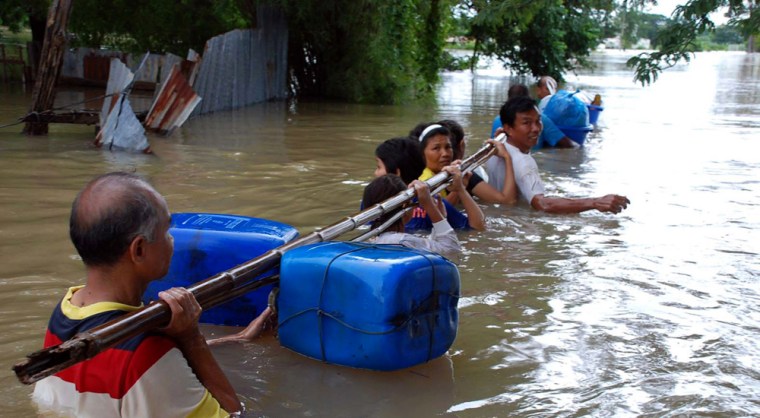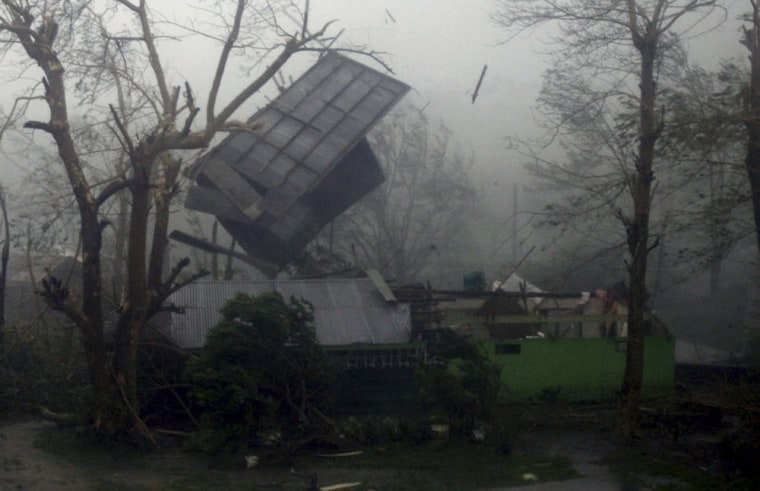A major cyclone made landfall in the country's north on Monday, killing at least three people, leaving a wasteland of fallen trees and power poles, and sending thousands fleeing to safety in near-zero visibility.
A retired general said bracing for the onslaught was like preparing for war.
said Megi, known locally as Juan, was a Category 5 super typhoon, the highest rating, with winds of more than 155 mph when it hit mountains in northeast Luzon overnight Sunday.
As Megi blew across the northern Philippines, forecasters said it would next hit China and Vietnam, where recent floods unrelated to the storm have caused 30 deaths.
On Monday, strong currents on Vietnam's flooded main highway swept away a bus and 20 of its passengers, including a boy pulled from his mother's grasp.
In China, authorities evacuated 140,000 people from a coastal province ahead of the typhoon.
Megi made landfall midday Monday at Palanan Bay in Isabela province, felling trees and utility poles and cutting off power, phone and Internet services. Its ferocious wind slightly weakened while crossing the mountains of the Philippines' main northern island of Luzon.
With more than 4,150 Filipinos riding out the typhoon in sturdy school buildings, town halls, churches and relatives' homes, roads in and out of coastal Isabela province, about 200 miles northeast of Manila, were deserted and blocked by collapsed trees, power lines and debris.
'State of calamity'"The governor of Isabela declared a state of calamity, so there could be massive damage and destruction there," Benito Ramos, executive director of the national disaster agency, told reporters.
"Power has been cut and crops about to be harvested could have been destroyed. We have no actual report because we're waiting for the weather to clear up to make an assessment." The National Telecommunications Commission said the storm might have knocked out up to 90 percent of communications in Isabela and Cagayan provinces.
One man who had just rescued his water buffalo slipped and fell into a river and drowned in Cagayan province, near Isabela. A tamarind tree crushed a house in Kalinga province, pinning a woman to death and injuring her child. In nearby Baguio city, and a security guard died after a pine tree struck him.
Falling trees, collapsed roofs and shattered glass injured at least six in the region, officials said.
As it crashed ashore, the typhoon whipped up huge waves. Visibility was near-zero and radio reports said the wind was so powerful that people could not take more than a step at a time. Authorities told ships and fishing vessels to stay in ports, and cancelled several domestic and international flights.
The entire Isabela province lost power along with 16 of Cagayan's 28 towns as the typhoon blew by. Cagayan Governor Alvaro Antonio said the wind was fierce but blew high from the ground, sparing many ricefields ready for harvesting.
Angelito Banayo, administrator of the National Food Authority told Reuters the government's worst case scenario was Megi could damage unmilled rice crop in the north with only 30 percent of it able to be harvested.
The Philippines is the world's biggest rice importer and damage from the typhoon could see it buy more than had been expected for 2011, which could push up international prices.
'Preparing for war'
Although initial casualties were low compared to past storm disasters, retired army Maj. Gen. Ramos said bracing for the typhoon was like "preparing for war."
"This was tougher because in war, I could take a nap," Ramos told The Associated Press.
Thousands of military reserve officers and volunteers were on standby, along with helicopters, including six Chinooks that committed by U.S. troops holding war exercises with Filipino soldiers near Manila, Ramos said.
In July, an angry President Benigno Aquino III fired the head of the weather bureau for failing to predict that a typhoon would hit Manila. That storm killed more than 100 people in Manila and outlying provinces.
This time, urgent preparations included evacuations and the positioning of emergency relief and food supplies days before the typhoon hit. The capital was expected to avoid any direct hit, though schools were closed.
Megi was the most powerful typhoon to hit the Philippines in four years, government forecasters said. A 2006 howler with 155-mph winds set off mudslides that buried entire villages, killing about 1,000 people.
In Vietnam, officials say up to 31.5 inches of rain have pounded areas in just a few days, forcing 126,000 people to flee their homes. Earlier flooding this month left more than 80 people dead or missing.
Megi could add to the misery.
Flood-weary residents
"People are exhausted," Vietnamese disaster official Nguyen Ngoc Giai said by telephone from Quang Binh province. "Many people have not even returned to their flooded homes from previous flooding, while many others who returned home several days ago were forced to be evacuated again."
China's National Meteorological Center said Megi was expected to enter the South China Sea on Tuesday, threatening southeastern coastal provinces. The center issued its second-highest alert for potential "wild winds and huge waves," warning vessels to take shelter and urging authorities to brace for emergencies.
Disaster response authorities ordered officials along the Chinese mainland coast to ready emergency supplies and prepare residents for possible floods and landslides with torrential downpours likely in coming days, including in provinces inland, the official Xinhua News Agency reported.
Nearly 140,000 people fled homes in the southern island province of Hainan, where heavy rains left thousands homeless over the weekend, Xinhua reported.

Thailand also reported flooding that killed at least four people, submerged thousands of homes and vehicles and halted train service. It also prompted the evacuation of nearly 100 elephants from a popular tourist attraction north of the capital.
